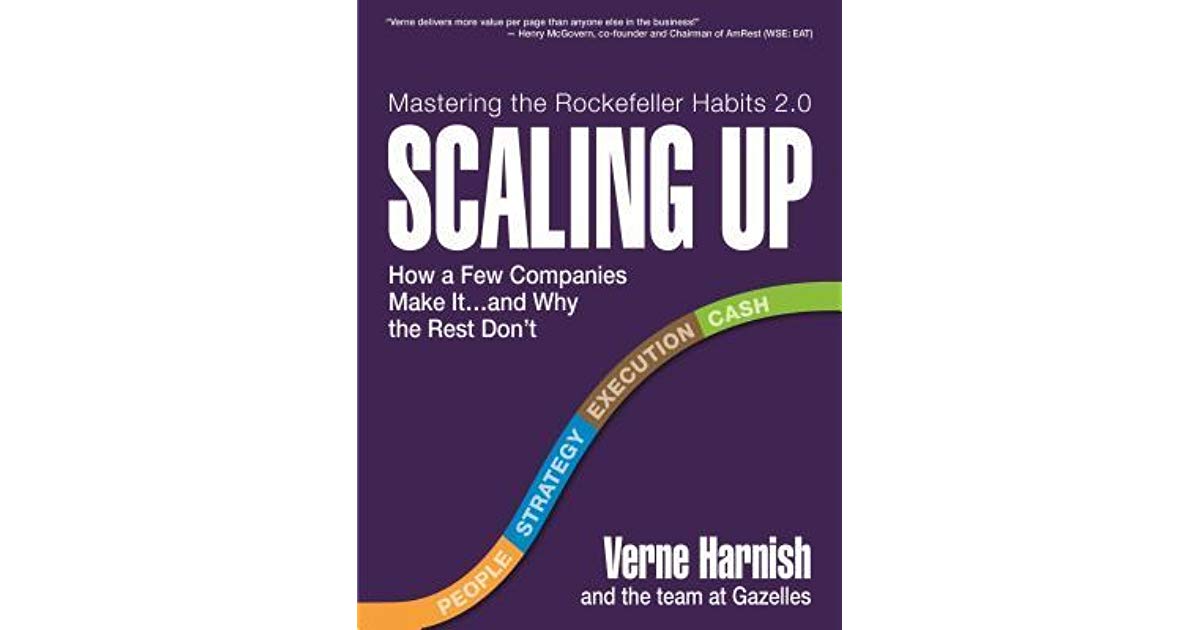Il m’arrive parfois de tomber sur un livre extraordinaire. Je n’arrive pas à savoir sur le moment si le livre est extraordinaire en soi, ou bien s’il est extraordinaire car il apporte des solutions immédiates à des questions immédiates. Je pense en fait que Scaling Up répond aux deux critères. Le livre est extra-ordinaire dans le sens où pour un livre de business il donne des dizaines d’exemples concrets utilisables immédiatement, et non une seule théorie vaguement définie et plus ou moins applicable. Mais il répond également très précisément à une question complexe : comment gérer la croissance d’une startup ? La question est complexe, car elle est multifactorielle. Le livre y répond en catégorisant 4 ensembles : les individus, la stratégie, l’exécution et le cash. Revenons ensemble sur une sélection de points que j’ai pensé les plus pertinents, avec pour cette première partie, les généralités et les individus.
Note : je ne traduis pas les citations originales, pour cela Google Translate fait un excellent travail.
Généralités
Leaders are readers. When Larry Page, CEO of Google was asked how he learned to run a company, he responded “I read a lot.” For instance, he read three books on how to name things. Bill Gates, for decades, maintained his famous “Think Week”, devouring a record 112 books/articles/whitepapers during one session. Having a natural curiosity and thirst for learning separates the good from the great in our experience.
Une fois encore, comme on a pu le voir dans bon nombre de biographies que j’ai résumées sur ce blog, une lecture assidue est bien souvent le point de départ de tous les succès.
You know you have execution issues if three things exist: 1. There is needless drama in the organization (e.g., something shipped out late; the invoice was wrong; someone missed a meeting; etc.). 2. Everyone seems to be working more hours, spinning his wheels, or spending too much time fixing things that should have been done right the first time. 3. Most important, the company is generating less than three times industry average profitability.
Lymo connaît aussi bien sûr des ratés, et des ratés évitables. C’est pour cela que la question d’une organisation mieux huilée se pose. Toute organisation en forte croissance doit nécessairement se la poser.
There’s an additional cruel and counterintuitive market dynamic when you’re growing a business. As the firm scales from $1 million to $10 million in revenue, the senior team tends to be focused externally on amassing new business. Yet this is precisely the time when a little more internal focus, to establish healthy organizational habits and a scalable infrastructure, would pay off in the long term. As the business scales past $10 million, organizational complexities tend to draw the attention of the senior team inward (leading to firefighting). This is precisely when the team needs to be focused more externally on the marketplace (by talking to customers, as Rudy does), given the increased competitive pressures that come with size.
Cette remarque a fait tilt chez moi. C’est exactement ce qui se passe chez Lymo à notre stade de développement. Les fondateurs doivent faire face à un nombre croissant de décisions opérationnelles à prendre. Ce qui les contraint à s’éloigner de l’extérieur, à un moment où la quête de nouveaux clients, talents, fournisseurs est fondamentale.
To deal with these challenges, the company must grow the capabilities of the leadership team throughout the organization; install scalable infrastructure to manage the increasing complexities that come with growth; and stay on top of the market dynamics that affect the business. To do this, there are 4 Decisions that leaders must address: People, Strategy, Execution, and Cash
Individus (« People »)
What defines the hills and valleys is related more to the number of employees than to revenue, since this is what drives the complexity equation mentioned above. If you figure roughly $100,000 revenue/employee for small firms and $250,000 revenue/employee for larger firms (yes, larger firms are more efficient on average); and you figure that one can lead seven to 10 others, you get some natural clusters: • One to three employees (the majority of home-based businesses) • Eight to 12 employees (a very efficient company with a leader and a bunch of helpers) • 40 to 70 employees (a senior team of five to seven people, leading teams of seven to 10 — in a company where you still know everyone’s name) • 350 to 500 employees (seven leaders, with seven middle managers each, running teams of seven to 10 — actually a very efficient company) • 2,500 to 3,500 employees (more multiples of seven to 10)
Cette remarque m’a tout de suite frappée : Lymo compte aujourd’hui 25 salariés. Nous sommes donc dans une phase de transition entre l’entreprise 8-12 personnes et celle de 45-70, et inévitablement des problèmes se posent :
Any company with an employee count between these natural clusters is likely feeling a bit stuck. Everything seems to take longer to complete. Problems you thought you had solved earlier start creeping up again. And you’re feeling this “big, but not big enough” syndrome — even in making minor decisions like what size photocopy machine you need next.
Il devient donc absolument nécessaire de recruter et former des experts opérationnels :
To get to 10 employees, founders must delegate activities in which they are weak. To get to 50 employees, they have to delegate functions in which they are strong!
Une fois recrutés, il faut manager ces personnes. Voilà les 4 clés de la bonne délégation :
Successful delegation requires four components, assuming you have delegated a job to the right person or team: 1. Pinpoint what the person or team needs to accomplish (Priorities — One-Page Strategic Plan). 2. Create a measurement system for monitoring progress (Data — qualitative and quantitative key performance indicators). 3. Provide feedback to the team or person (Meeting Rhythm). 4. Give appropriately timed recognition and reward (because we’re dealing with people, not machines). The leader’s final job is “to keep the main thing the main thing” — to keep the organization on message and everyone heading in the same direction.
J’adore l’idée très concrète qui est énoncée juste après : assigner un responsable à chaque ligne du compte de résultat de la société :
It was Jack Stack, founder and CEO of SRC Holdings Corporation and author of the classic book The Great Game of Business: The Only Sensible Way to Run a Company, who argued that the Phoenician monks left out a critical column on the first accounting statements they created in the late 1400s: the “Who” column. There should be a person clearly accountable for each line item, even if it’s a middle or lower manager, when considering a highly detailed P&L and B/S.
Dans l’évolution de la société, le fondateurs doivent se muer en coach auprès des nouveaux responsables de opérationnels, qui sont véritables « mini-PDG » :
To navigate this organizational transition, the functional heads, who have been used to driving the business, need to adapt. They need to become more like coaches/advisors to the business unit leaders, rather than acting as their “bosses.” In turn, the heads of the business units need to lead as if they are individual CEOs. You don’t want weak “yes-people” heading up your business units.
Une autre très bonne idée à retenir : pour effectuer un recrutement, ne plus se baser sur une fiche de poste détaillant ce que le candidat devra faire, mais plutôt sur les objectifs qu’il devra réaliser :
Being specific about outcomes allows you to directly evaluate each candidate’s capacity to actually deliver these results. Can you really see the person you’re interviewing taking your top line from $20 million to $35 million over the next three years? Is there anything in her history of results that supports this conclusion?
Les 4 valeurs à rechercher chez un candidat :
It’s important to hire the best A Player you can find for each position in your company based on four criteria (in this order!): • Will — a desire to excel, act with courage, persevere, learn, and innovate • Values — the test for culture fit – do they align with your core values • Results — in the end can they deliver on your KPIs/outcomes • Skills — the least important since most skill-sets need updating every 5 years.
Les 5 qualités des bons managers :
From our experience, great managers must focus those coaching sessions with their “direct supports” (a better term than “direct reports”) on five topics representing the five main activities of successful managers. In reverse order of importance: 5. Hire fewer people, but pay them more. 4. Give recognition, and show appreciation. 3. Set clear expectations, and give employees a clear line of sight. 2. Don’t demotivate; “dehassle.” 1. Help people play to their strengths. Let’s look at each of these activities in detail.
Ne pas oublier de congratuler 3x plus qu’on ne réprimande (l’auteur ajoute que dans un couple c’est 5 fois plus !) :
Studies have shown that for people to be happy and productive at work, they need to experience positive interactions (appreciation, praise) vs. negative (reprimands, criticism) with their manager in a ratio of at least 3:1.
Enfin, l’auteur répond à la question : qu’est-ce qui différencie un manager d’un leader ?
Are You a Manager or a Leader? Ask a good manager about his team and he will speak in generalities, saying that they are hardworking, responsible, fun, etc. Ask a great manager the same question and she will describe each of her team members with specific details about their personality, strengths, and achievements. Again, think about the “A-Team” action television analogy from the last chapter. Managing is about differences; leading is about sameness. Great managers discover what is different about people and capitalize on it. Great leaders discover what is universal, build a common vision for a better future around it, and then rally people behind it.







Laisser un commentaire